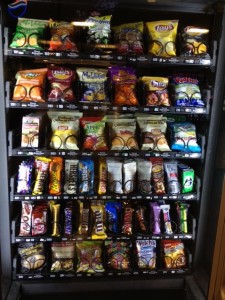Summary of Research Proposal Presentation
On Wednesday our group had to present our research proposal, summarized below:
Our group will be taking steps to assess the current healthy snacks offered in UBC vending machines under the Gage Snack Vending Model (GSVM). This research is being conducted in order to understand what aspects of the GSVM work versus what aspects need work, and to incorporate community feedback into its design. Our aim is to find a working compromise between consumer preferences and what healthy options the vendor is able to bring in. The GSVM’s introduction was a positive change, but the model is not yet ideal so to follow-up and continue developing the GSVM, our CBEL project will focus on the following:
- What improvements can be made to the Gage Snack Vending Model already in place on UBC campus?
- How can the scope of the model be expanded to include beverage vending machines?
Our research will be conducted using qualitative (observation) and quantitative (surveying) methods. In this mixed-method design, the benefits of using both allow us to answer our exploratory research questions through detailed note-taking (a qualitative approach), while still being able to compile meaningful statistics about our research population through surveys (quantitative analyses). Key sources of information we will use are past research done by LFS students on UBC vending machines, the Healthy Choice Vending Machine Policy, communications with our community contact, and the Coca-Cola Canada website.
To begin our research, we will perform an audit on all GSVM and beverage vending machines to see how closely the HCVMP is being followed. In addition, we will be looking at sales, correct signage, and cleanliness. Our audit will be followed by observation of consumer habits at the vending machines. We will then use surveys throughout the campus to retrieve information on community preferences. The surveys will mainly consist of ranked questions, with one or two open-ended questions. We will also conduct taste-tests for already-available healthy products (as per the GSVM) to determine which are well-liked and worth keeping.
We created a timeline to help us organize our time and accomplish our goals. Listed below is a general summary of our expected outcomes:
October
- Review the BC ministry policy
- Conduct audit on GVSM machines and beverage machines
- Conduct surveys at different locations across UBC campus
November
- We will report group CBEL findings and analyze the survey
- Arrange a final meeting with Victoria and Liska
- Divide the work for the CBEL project final report
- Divide the work to prepare and rehearse the CBEL project plenary presentation.
By following our work plan, we hope to efficiently meet our project goals: determining any current problems with the GSVM, and suggesting changes to establish a better working model for snack and beverage vending.
What we Learned as a Group from our Proposal Presentation
We received much feedback from our substitute TA after the presentation. First and foremost, our research questions, which was composed of several questions was refined to two very specific questions. By having more specific questions, we can directly navigate our attention to what our goals are. We also considered some questions that can be incorporated into our surveys. Three questions will be asked: 1) When was the last time you used a Gage Snack vending machine? 2) How often do you use vending machines? and 3) When have you bought snacks from the vending machine?
What to Expect Next
Our group will be navigating the reading group discussion this week on an article: Should We Go Home to Eat?: toward a Reflexive Politics of Localism written by E. Melanie DuPuis and David Goodman. The authors’ main point in this paper is that the term “local” is too ambiguous, and by not being clearly defined, localism as a political movement is resulting in unreflexive localism as demonstrated by the local food movements in the US and the EU, leading to potentially undemocratic and unrepresentative solutions. The next main point is about inequality: Food reform is largely being controlled by consumers of particular class and ethnicity. This is a problem because corporations are taking advantage of and minorities are not being considered. Like previously mentioned, we will lead a critical discussion based on this article on Wednesday.
As for our CBEL project, now that we have a clear understanding of what we are planning to accomplish, we will plan a group meeting in the near future to discuss potential survey questions among other things. We are expected to finish our survey questions and have them ready to distribute to students for the following week. As we plan our surveys and taste test, we will be taking some time off to enjoy the holiday with our family and friends.
Happy Thanksgiving!
Group 26



